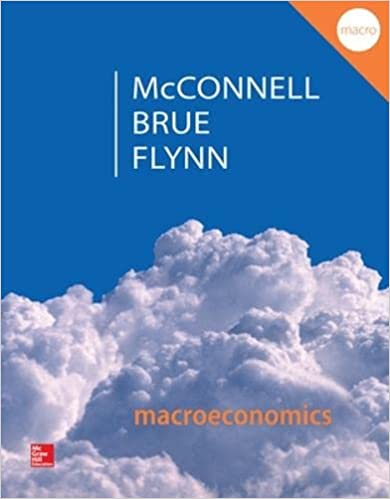
Macroeconomics 20th Edition by Campbell McConnell ,Stanley Brue ,Sean Flynn
Edition 20ISBN: 978-0077660772
Macroeconomics 20th Edition by Campbell McConnell ,Stanley Brue ,Sean Flynn
Edition 20ISBN: 978-0077660772 Exercise 15
In the accompanying tables you will find consolidated balance sheets for the commercial banking system and the 12 Federal Reserve Banks. Use columns 1 through 3 to indicate how the balance sheets would read after each of transactions a to c is completed. Do not cumulate your answers; that is, analyze each transaction separately, starting in each case from the numbers provided. All accounts are in billions of dollars. LO2 

a. A decline in the discount rate prompts commercial banks to borrow an additional $1 billion from the Federal Reserve Banks. Show the new balance-sheet numbers in column 1 of each table.
b. The Federal Reserve Banks sell $3 billion in securities to members of the public, who pay for the bonds with checks. Show the new balance-sheet numbers in column 2 of each table.
c. The Federal Reserve Banks buy $2 billion of securities from commercial banks. Show the new balance-sheet numbers in column 3 of each table.
d. Now review each of the above three transactions, asking yourself these three questions: (1) What change, if any, took place in the money supply as a direct and immediate result of each transaction? (2) What increase or decrease in the commercial banks' reserves took place in each transaction? (3) Assuming a reserve ratio of 20 percent, what change in the money-creating potential of the commercial banking system occurred as a result of each transaction?


a. A decline in the discount rate prompts commercial banks to borrow an additional $1 billion from the Federal Reserve Banks. Show the new balance-sheet numbers in column 1 of each table.
b. The Federal Reserve Banks sell $3 billion in securities to members of the public, who pay for the bonds with checks. Show the new balance-sheet numbers in column 2 of each table.
c. The Federal Reserve Banks buy $2 billion of securities from commercial banks. Show the new balance-sheet numbers in column 3 of each table.
d. Now review each of the above three transactions, asking yourself these three questions: (1) What change, if any, took place in the money supply as a direct and immediate result of each transaction? (2) What increase or decrease in the commercial banks' reserves took place in each transaction? (3) Assuming a reserve ratio of 20 percent, what change in the money-creating potential of the commercial banking system occurred as a result of each transaction?
Explanation
One of the uninsured groups is the group...
Macroeconomics 20th Edition by Campbell McConnell ,Stanley Brue ,Sean Flynn
Why don’t you like this exercise?
Other Minimum 8 character and maximum 255 character
Character 255


